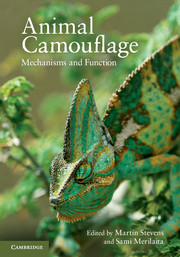Book contents
- Frontmatter
- Contents
- Contributors
- 1 Animal camouflage
- 2 Crypsis through background matching
- 3 The concealment of body parts through coincident disruptive coloration
- 4 The history, theory and evidence for a cryptic function of countershading
- 5 Camouflage-breaking mathematical operators and countershading
- 6 Nature's artistry
- 7 Camouflage behaviour and body orientation on backgrounds containing directional patterns
- 8 Camouflage and visual perception
- 9 Rapid adaptive camouflage in cephalopods
- 10 What can camouflage tell us about non-human visual perception? A case study of multiple cue use in cuttlefish (Sepia spp.)
- 11 Camouflage in marine fish
- 12 Camouflage in decorator crabs
- 13 Camouflage in colour-changing animals
- 14 The multiple disguises of spiders
- 15 Effects of animal camouflage on the evolution of live backgrounds
- 16 The functions of black-and-white coloration in mammals
- 17 Evidence for camouflage involving senses other than vision
- Index
- Plate section
- References
7 - Camouflage behaviour and body orientation on backgrounds containing directional patterns
Published online by Cambridge University Press: 05 June 2012
- Frontmatter
- Contents
- Contributors
- 1 Animal camouflage
- 2 Crypsis through background matching
- 3 The concealment of body parts through coincident disruptive coloration
- 4 The history, theory and evidence for a cryptic function of countershading
- 5 Camouflage-breaking mathematical operators and countershading
- 6 Nature's artistry
- 7 Camouflage behaviour and body orientation on backgrounds containing directional patterns
- 8 Camouflage and visual perception
- 9 Rapid adaptive camouflage in cephalopods
- 10 What can camouflage tell us about non-human visual perception? A case study of multiple cue use in cuttlefish (Sepia spp.)
- 11 Camouflage in marine fish
- 12 Camouflage in decorator crabs
- 13 Camouflage in colour-changing animals
- 14 The multiple disguises of spiders
- 15 Effects of animal camouflage on the evolution of live backgrounds
- 16 The functions of black-and-white coloration in mammals
- 17 Evidence for camouflage involving senses other than vision
- Index
- Plate section
- References
Summary
The best-known interrelated mechanisms through which coloration can act to reduce predator detection rates of potential prey are background matching and disruptive coloration (Thayer 1909; Cott 1940; Kingsland 1978; Ruxton et al. 2004; Wilkinson & Sherratt 2008; Stevens & Merilaita 2009). With background matching, objects are difficult to detect simply due to their similarity to their background. Conversely, the striking/high-contrast markings involved in disruptive coloration create ‘the appearance of false edges and boundaries and hinders the detection or recognition of an object's outline and shape’ (Stevens & Merilaita 2009). Coloration is but one means through which animals achieve crypsis; others include behaviour and morphology, including body size and shape. Here we focus on behaviour and its interaction with coloration in relation to crypsis.
- Type
- Chapter
- Information
- Animal CamouflageMechanisms and Function, pp. 101 - 117Publisher: Cambridge University PressPrint publication year: 2011
References
- 1
- Cited by



